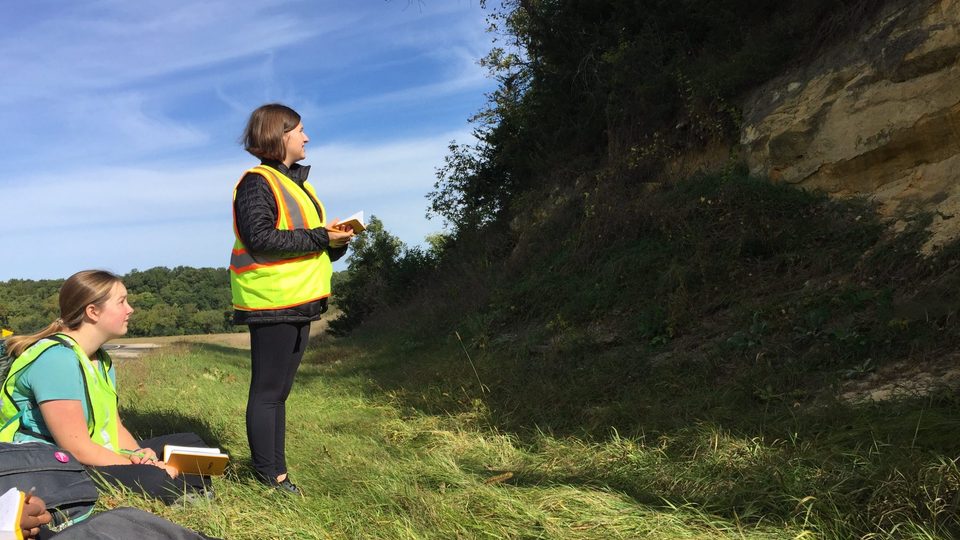Intro to Field Geology offers exploration and adventure
The Geology faculty offers a range of field-based introductory courses each year, with focuses including environmental geology and climate change.

 Geology Professor Mary Savina ‘72 started this year’s Argument and Inquiry Seminar Convocation by speaking of her own experiences as a Carleton student in 1968. Over the course of that year, she took two “freshman seminars” through a preliminary program to engage first-years that would later become the Argument and Inquiry seminars that all Carleton students take today. One, entitled “Man and his Natural Environment,” was the first geology course Savina ever took.
Geology Professor Mary Savina ‘72 started this year’s Argument and Inquiry Seminar Convocation by speaking of her own experiences as a Carleton student in 1968. Over the course of that year, she took two “freshman seminars” through a preliminary program to engage first-years that would later become the Argument and Inquiry seminars that all Carleton students take today. One, entitled “Man and his Natural Environment,” was the first geology course Savina ever took.
Although the course title may sound antiquated, when Savina shared more, it sounded surprisingly similar to a class I’m taking in my own first year at Carleton: Introduction to Field Geology. In fact, her course description promised then that “approximately half of the course will be spent in extended field trips through Minnesota and adjacent Wisconsin studying the last two billion years of geologic history”; mine, that “much of the classroom and lab time will be spent outdoors at nearby sites of geological interest … [and] students will piece together the most important elements of the long and complex geologic history of southern Minnesota.”
The parallels don’t end in the course catalog, either. Savina sparked recognition in me when she recounted her field trips, in which two professors would drive the students to an outcrop of rocks, then leave them there for two hours to figure out what story the rocks told. She could have been describing my course’s field trips to rocks around southern Minnesota—including some of the same sites that Savina visited in 1968—although my professor, Cameron Davidson, thankfully hasn’t abandoned us yet.
Learning that Introduction to Field Geology seemed to crop up around 50 years ago piqued my curiosity in the evolution of geology classes at Carleton. I sat down with Savina and Davidson to learn more about the history of the department.
Savina arrived to our interview late because she and sedimentologist Clint Cowan ’83 were passionately discussing the geologic composition of the new bathroom floors in Anderson Hall. Clearly, this is a faculty who love what they study. According to Savina, the same was true of her professors in that first class, Ed Buchwald and Eiler Henrickson. The former was new to the department and trying to “nudge it in a certain direction.” When I reached out to him, now a professor emeritus, he enthusiastically provided some context: he started at Carleton as one of a few faculty members in a department with almost as few students. He was worried that he might lose his new job, so he “created a course for freshmen that might attract people to consider majoring.”
At the time, introductory classes tended to be fairly large and mostly lecture based. Savina quipped that Buchwald described those classes, which center around rock identification in the classroom and still persist in geology programs elsewhere, as “terminal geology.” In contrast, it’s no wonder that a course which promised hours of field time was wildly popular: Buchwald said that about 60 students tried to enroll. He had to ask who had gone camping before to narrow them down to the most outdoorsy 24.
Buchwald’s idea worked in the long term, too. In Savina’s year, the Class of 1972, there were six geology majors; by the time she started teaching six years later, the senior class had 20. Cowan’s year, the Class of 1983, set the record with 41. Now the number of majors hovers steadily around 20 a year, a significant proportion of a 500-person class at a liberal arts college. Of them, about four a year go on to earn PhDs in geology. The rest take their experience in the field to careers in environmental sectors, law, medicine, education and more. In Davidson’s words, “the more the merrier.”
The department lives by this mantra. Continuing where Buchwald left off, the faculty offers a range of field-based introductory courses each year, with focuses including environmental geology and climate change. New courses are always being added, including one offered this winter on the geology of national parks. The department also offers off-campus study opportunities and shorter mid-term break trips that are free of charge for any geology student, major or not. (Next weekend, speaking of national parks, I’ll be getting on a geology bus to the Badlands and Black Hills of South Dakota.)
As for my class, Introduction to Field Geology? Savina confirmed that it does indeed stem from the seminar she took in 1968, back when she was in my shoes. It “went on hiatus” for a while, but returned as an A&I when they were introduced around 10 years ago. Now it’s open to any first-year or sophomore who, like Savina did then and I do now, wants to get out into the field.